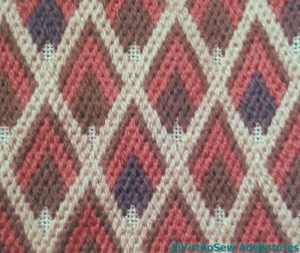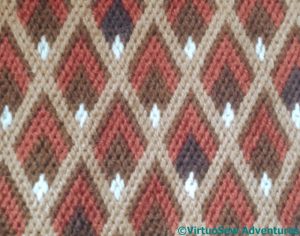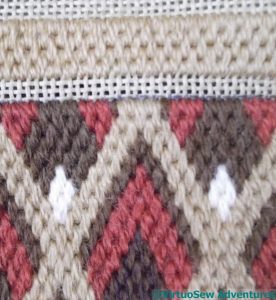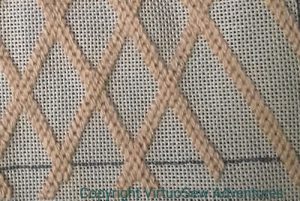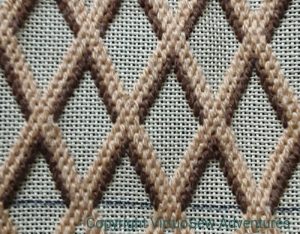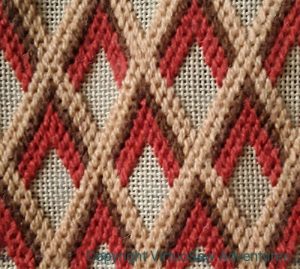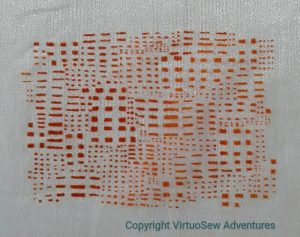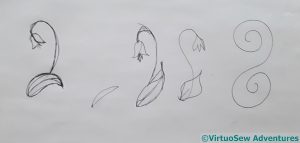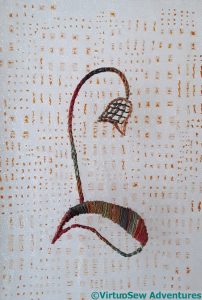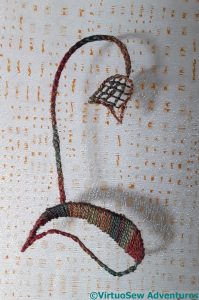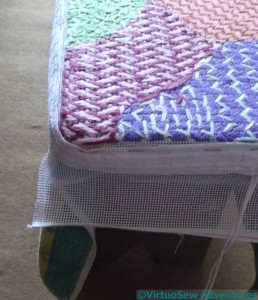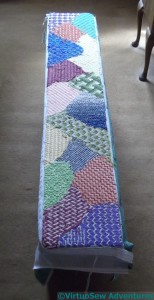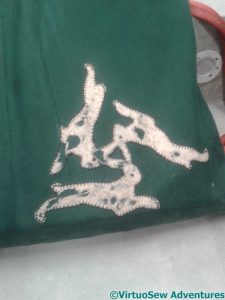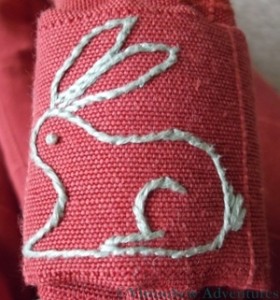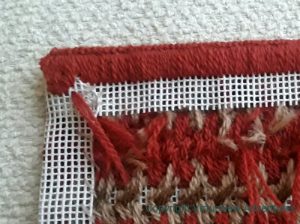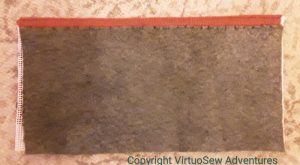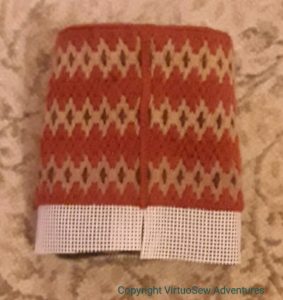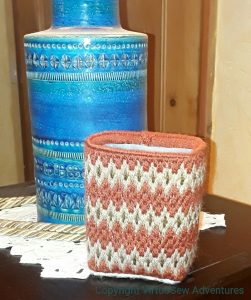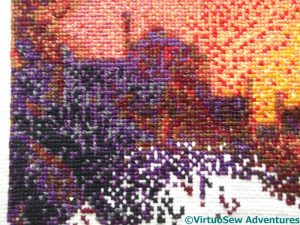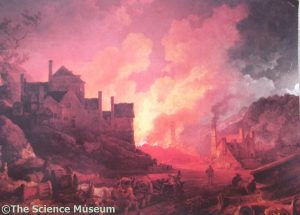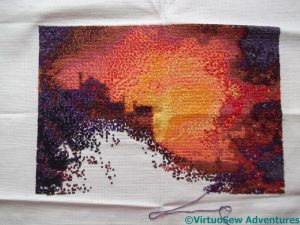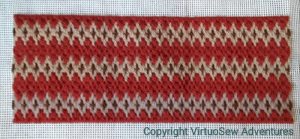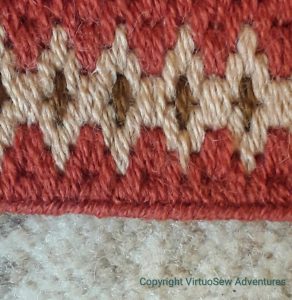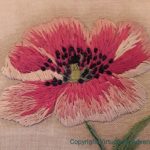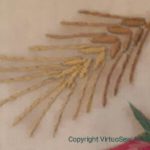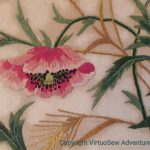Category: General Embroidery
Shadow Play
I decided, as I stared at the printing of this blocky pattern onto gauze, that I wanted to use the transparency of the gauze as part of the finished effect.
I don’t have a destination in mind for this piece which will give me a theme, so I decided that, in order to highlight that one quality, I would use a single thread (as it happened, a variegated silk), and design a fragment that would allow me to experiment with the effect of stitch cover and openness.
I leafed through books about pattern, saw nothing that gave me the combination I wanted, and then evolved the fragmentary organic sketch on the far left to give me the balance of line and form I was looking for. Incidentally, this is quite possibly the swiftest and shortest progression of any sketched design I’ve ever come up with!
It’s astonishingly difficult to trace a design onto a fabric which is essentially invisible, and still harder, I might add, to follow the lines when you have finally put them there!
I used Hungarian Braided Chain Stitch for the stem, satin stitch for the solid side of the leaf, and Jacobean trellis for the flower-head. Clearly that gives me a solid coverage, and a firm line; I was hoping that the Jacobean trellis might offer a sort of half-shade.
A qualified success, I’d say. The printed pattern doesn’t create a shadow, and the Jacobean trellis shadow isn’t a sort of half-depth.
But, my goodness, the shadow of the stem and the leaf work exactly as I hoped! The gauze itself almost disappears, leaving the printed pattern floating above the surface, and the leaf and flower thrown forward by their shadows.
Three Rabbits – or are they Hares?
Rummaging around as I try to reorganise the house, I’ve rediscovered a bag I made some time ago.
The Three Rabbits (or Hares) design is an ancient one, found all along the Silk Route and in many different cultures. I’ve seen it in textiles and ceramics, carved as mere outlines, polychrome with a wealth of fabulous detail. I’ve also seen variants with animals other than hares, and even variants with more animals in the circuit.
I think I first encountered it when I first met David Singmaster, the mathematician and metagrobologist – it’s one of his many interests, and he has a drawstring bag decorated with the design that he takes everywhere, stocked with mathematical puzzles and games to entertain anyone who comes near. I saw it recently when David and his wife were at a conference my husband and I attended, and his wife remembered that her mother had had to remind her of how to do the French Knots for the eyes. I took delight in noting the puzzled brows that ensued whenever David took anything out of the bag!
My version is one of the simplest, I suspect. I designed a very simple circuit of hares (or rabbits!), and embroidered it using chain stitch on a russet coloured furnishing fabric. The bag is padded with wadding and lined with the same fabric.
Finally I designed a small buckle-type ornament made of a strip of fabric embroidered with a very definite bunny embroidered in stem stitch, and put one on each end of the strap.
I’m intending to do a much more complicated version one of these days, maybe with a mille-fleurs background like the tapestries in the Musée de Cluny.
Watch this space, as they say!
Coalbrookdale in Cross Stitch
Many years ago I used to design counted cross stitch kits, and did some for the Ironbridge Gorge Museum. I did think of turning a certain very famous picture into a kit, but since we never finished the test stitch, it is just as well they decided not to go with it.
This is something else we’ve found in a fit of tidying up, and thought,”hmm, we should finish that – it will look good!”
It was done in the early days of computer-aided cross stitch design. I scanned a postcard of “Coalbrookdale By Night”, in the somewhat apocalyptic vision of Philip James de Loutherberg, and then spent some time tweaking the number of colours the computer used to render the design as a cross stitch piece. One of the problems with this form of computer design was that, no matter how much human intervention was involved, the design tended to end up being a bit spotty.
You can see that spotty effect in the detail picture above.
The human intervention did at least result in the removal of the entirely superfluous lime green stitches that the computer package used to scatter across every design it was involved in. I never did understand why that happened, but the first change I always had to make was to change the lime green into something more suitable.
What I have to do now is think of something useful to turn it into when it’s finished….
17 UFOs in 2017
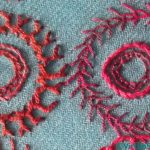
Still More Circles
Meredithe (Pomegranate and Chintz) and Anne (Frayed At The Edge) are running a challenge for the year – 17 UFOs in 2017. The idea is not necessarily to finish, but to make substantial progress, on 17 UFOs.
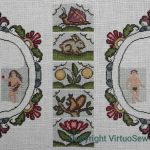
Now, I’m not sure I have that many UFOs, and I have many new projects I want to work on (more on those soon), but I do have a good few that are stalled, or that I’m not sure whether I’ve finished or not, so although I’m not going to join in regularly, I will try to use the impetus of the challenge to remind myself to assess progress.
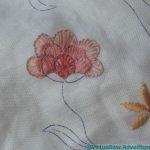
Blanket Stitch Fans
1 Eve in the Garden of Eden – I really want to finish this so I can sign up for the Stumpwork Lion!
2 Nefertiti Shawl – well, clearly, I want to be able to wear this!
3 Queen Anne style teacloth – this is a travelling project, so it depends on where I go and whether I have light or time to work on it.
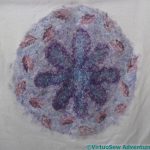
From The Back
4 The Modern Stitch-Off – I’m not sure whether this is finished or not, so if I can at least decide that by the end of the year, I’ll be pleased.
5 The Christmas Angel – I was going to work on the Christmas Angel last year between Christmas and Epiphany, and never set a stitch on it.
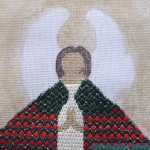
Shoulder Cape
6 The Faience Necklace – this has been a real trial to me, as I can’t bring the design into focus. I’ve got some lovely silk thread so maybe that will help me to get started.
7 The Swan – I got the first layer of Laid and Couched work done, and have had trouble working out the detail layer…
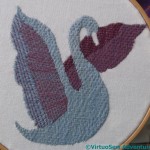
Swan – First Layer
8 The Unicorn – again, first layer done, details escaping me.
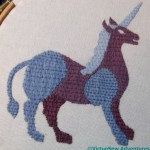
Unicorn – the first layer
I have a lot of other things I want to do, which are barely begun, never mind finished, and as I have said, in the case of several of these projects it is not a matter of simply stitching, so much as deciding what to stitch, and then stitching it.
My real target for the year with these eight is to have finished the Nefertiti Shawl and Eve in the Garden of Eden. Anything else is a bonus!
Poppies And Wheat, Cleaned and Conserved
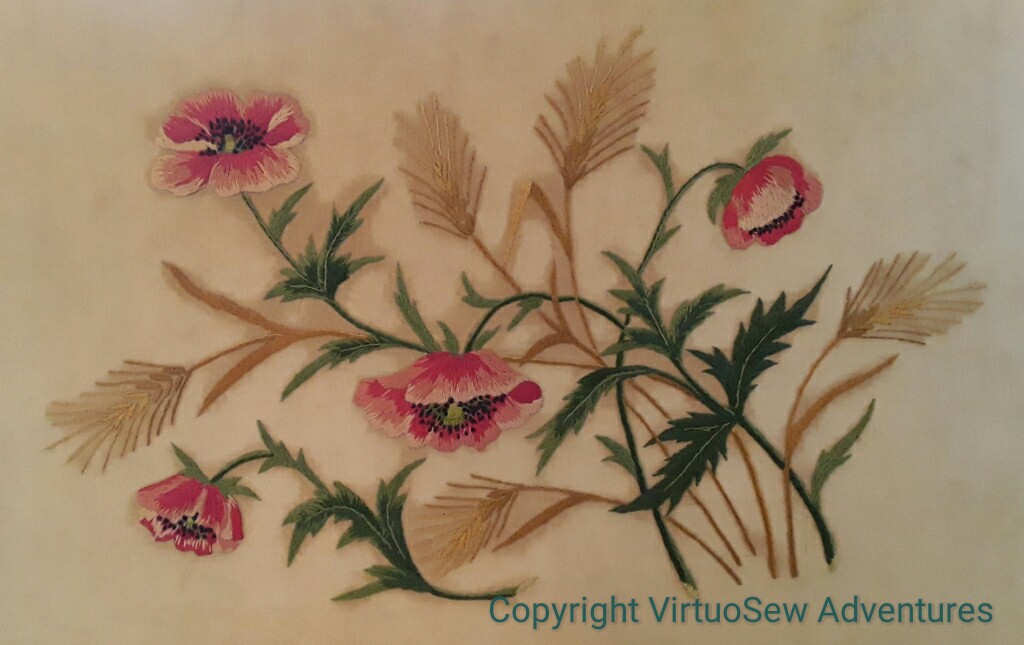
Some of you may recall that some time ago, my mother and I were planning to reframe one of my Grandmama’s embroideries, and discovered to our horror that it had been glued to a backing board made of strawboard.
In due course, we found a textile restorer, not too far away, and I took it to her. And now we have it back again. In the course of the work, it was discovered that two different sorts of glue had been used. One of them was unstuck fairly easily, but a particularly acidic glue had been used on the back of the embroidery itself – almost as if the framer did not believe the work had been finished off properly. Which it had – apparently it was very difficult to find some threads to take out to test for colourfastness!
- Poppy – Brighter and Lighter
- Wheatear – Brighter and Lighter
- Further Detail – Brighter and Lighter
The fabric and thread are both much brighter than they were, but the very acidic glue that was used is the reason for the bloom of staining around the embroidery. It’s much reduced, but unfortunately it wasn’t possible to remove it entirely.
So, Gentle Reader – be careful with glues and boards. Avoid if you can, use neutral-pH as far as you can, or someone in the future will be muttering imprecations in your direction!

